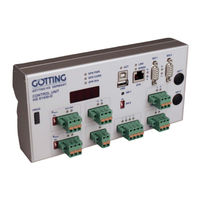Gotting HG G-73650ZD Manuals
Manuals and User Guides for Gotting HG G-73650ZD. We have 2 Gotting HG G-73650ZD manuals available for free PDF download: Basics, Setup And Software
Gotting HG G-73650ZD Basics, Setup And Software (206 pages)
Navigation Controller
Brand: Gotting
|
Category: Controller
|
Size: 11 MB
Table of Contents
-
Overview
3-
Symbols9
-
Intended Use10
-
-
Freeze ONS14
-
The Odometry14
-
Attributes29
-
Spot Turn32
-
Speed Ramp36
-
Stop Ramp37
-
Idle Mode42
-
Hardware45
-
Front Panel46
-
Mounting46
-
Connectors48
-
Eth48
-
Usb48
-
Can 149
-
Sio 249
-
Can 250
-
Power50
-
Sio 350
-
Ant1 / Ant251
-
Prog51
-
Main Menu54
-
Status55
-
Status Menu55
-
Deviation56
-
Seg. Table56
-
Segment56
-
Plc57
-
Antenna58
-
Odometry59
-
Result59
-
Gps60
-
GPS Menu60
-
Ons60
-
Status61
-
Position62
-
Status62
-
Utc62
-
Accuracy63
-
Base Vector63
-
Heading63
-
Satellites63
-
Error Menu64
-
TCP Menu65
-
Wheels69
-
Network Menu89
-
Download91
-
Main Menu99
-
Display Output100
-
Display Output103
-
D: Data Logging105
-
Display Output106
-
N: Show Segments108
-
Commissioning111
-
-
CAN Bus Protocol130
-
Path Data Box132
-
Status Box132
-
Error Box135
-
Wheel Boxes141
-
Gyro Box143
-
Servo Box143
-
ME1 Box144
-
ME2 Box145
-
Pol X/Y CAN2 Box145
-
PLC Control Box146
-
Wheel Box150
-
Antenna Boxes151
-
Servo Box151
-
Gyro Box152
-
Vector Box155
-
ME PDO 1 Box156
-
ME PDO 2 Box157
-
ME PDO 3 Box157
-
Trailer Box158
-
Trouble Shooting185
-
Technical Data187
-
Appendix
188-
Attributes188
-
-
-
List of Tables199
-
Index202
-
Copyright205
-
Advertisement
Gotting HG G-73650ZD Basics, Setup And Software (158 pages)
Navigation Controller
Brand: Gotting
|
Category: Controller
|
Size: 6 MB
Table of Contents
-
Symbols8
-
The Odometry13
-
Gps18
-
Attributes26
-
Spot Turn29
-
Idle Mode35
-
Hardware38
-
Mounting39
-
Front Panel39
-
Connectors40
-
Eth40
-
Usb41
-
Sio 241
-
Can 142
-
Can 242
-
Sio 342
-
Power43
-
Prog44
-
Ant1 / Ant244
-
Software45
-
Main Menu46
-
Status Menu47
-
Status47
-
Deviation48
-
Seg. Table48
-
Segment48
-
Plc49
-
Antenna50
-
Result51
-
Odometry51
-
Gps52
-
Ons53
-
Status54
-
GPS Receiver55
-
Utc55
-
Status55
-
Position55
-
Satellites55
-
Accuracy55
-
Base Vector56
-
Heading56
-
Error57
-
Tcp58
-
Wheels61
-
Network Menu78
-
CAN Bus Protocol105
-
Path Data Box107
-
Status Box108
-
Error Box109
-
Wheel Boxes113
-
Gyro Box115
-
SPS Control Box117
-
Wheel Box119
-
Antenna Boxes119
-
Gyro Box120
-
Feldbus Protocol124
-
Trouble Shooting143
-
Technical Data145
-
Appendix146
-
A Attributes146
-
List of Figures152
Advertisement

